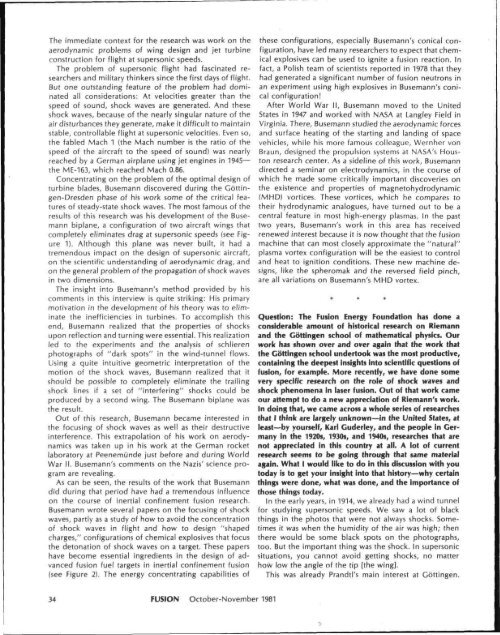Riemann's Contribution to Flight and Laser Fusion
Riemann's Contribution to Flight and Laser Fusion
Riemann's Contribution to Flight and Laser Fusion
- No tags were found...
You also want an ePaper? Increase the reach of your titles
YUMPU automatically turns print PDFs into web optimized ePapers that Google loves.
The immediate context for the research was work on theaerodynamic problems of wing design <strong>and</strong> jet turbineconstruction for flight at supersonic speeds.The problem of supersonic flight had fascinated researchers<strong>and</strong> military thinkers since the first days of flight.But one outst<strong>and</strong>ing feature of the problem had dominatedall considerations: At velocities greater than thespeed of sound, shock waves are generated. And theseshock waves, because of the nearly singular nature of theair disturbances they generate, make it difficult <strong>to</strong> maintainstable, controllable flight at supersonic velocities. Even so,the fabled Mach 1 (the Mach number is the ratio of thespeed of the aircraft <strong>to</strong> the speed of sound) was nearlyreached by a German airplane using jet engines in 1945—the ME-163, which reached Mach 0.86.Concentrating on the problem of the optimal design ofturbine blades, Busemann discovered during the Gottingen-Dresdenphase of his work some of the critical featuresof steady-state shock waves. The most famous of theresults of this research was his development of the Busemannbiplane, a configuration of two aircraft wings thatcompletely eliminates drag at supersonic speeds (see Figure1). Although this plane was never built, it had atremendous impact on the design of supersonic aircraft,on the scientific underst<strong>and</strong>ing of aerodynamic drag, <strong>and</strong>on the general problem of the propagation of shock wavesin two dimensions.The insight in<strong>to</strong> Busemann's method provided by hiscomments in this interview is quite striking: His primarymotivation in the development of his theory was <strong>to</strong> eliminatethe inefficiencies in turbines. To accomplish thisend, Busemann realized that the properties of shocksupon reflection <strong>and</strong> turning were essential. This realizationled <strong>to</strong> the experiments <strong>and</strong> the analysis of schlierenpho<strong>to</strong>graphs of "dark spots" in the wind-tunnel flows.Using a quite intuitive geometric interpretation of themotion of the shock waves, Busemann realized that itshould be possible <strong>to</strong> completely eliminate the trailingshock lines if a set of "interfering" shocks could beproduced by a second wing. The Busemann biplane wasthe result.Out of this research, Busemann became interested inthe focusing of shock waves as well as their destructiveinterference. This extrapolation of his work on aerodynamicswas taken up in his work at the German rocketlabora<strong>to</strong>ry at Peenemiinde just before <strong>and</strong> during WorldWar II. Busemann's comments on the Nazis' science programare revealing.As can be seen, the results of the work that Busemanndid during that period have had a tremendous influenceon the course of inertial confinement fusion research.Busemann wrote several papers on the focusing of shockwaves, partly as a study of how <strong>to</strong> avoid the concentrationof shock waves in flight <strong>and</strong> how <strong>to</strong> design "shapedcharges," configurations of chemical explosives that focusthe de<strong>to</strong>nation of shock waves on a target. These papershave become essential ingredients in the design of advancedfusion fuel targets in inertial confinement fusion(see Figure 2). The energy concentrating capabilities ofthese configurations, especially Busemann's conical configuration,have led many researchers <strong>to</strong> expect that chemicalexplosives can be used <strong>to</strong> ignite a fusion reaction. Infact, a Polish team of scientists reported in 1978 that theyhad generated a significant number of fusion neutrons inan experiment using high explosives in Busemann's conicalconfiguration!After World War II, Busemann moved <strong>to</strong> the UnitedStates in 1947 <strong>and</strong> worked with NASA at Langley Field inVirginia. There, Busemann studied the aerodynamic forces<strong>and</strong> surface heating of the starting <strong>and</strong> l<strong>and</strong>ing of spacevehicles, while his more famous colleague, Wernher vonBraun, designed the propulsion systems at NASA's Hous<strong>to</strong>nresearch center. As a sideline of this work, Busemanndirected a seminar on electrodynamics, in the course ofwhich he made some critically important discoveries onthe existence <strong>and</strong> properties of magne<strong>to</strong>hydrodynamic(MHD) vortices. These vortices, which he compares <strong>to</strong>their hydrodynamic analogues, have turned out <strong>to</strong> be acentral feature in most high-energy plasmas. In the pasttwo years, Busemann's work in this area has receivedrenewed interest because it is now thought that the fusionmachine that can most closely approximate the "natural"plasma vortex configuration will be the easiest <strong>to</strong> control<strong>and</strong> heat <strong>to</strong> ignition conditions. These new machine designs,like the spheromak <strong>and</strong> the reversed field pinch,are all variations on Busemann's MHD vortex.* * *Question: The <strong>Fusion</strong> Energy Foundation has done aconsiderable amount of his<strong>to</strong>rical research on Riemann<strong>and</strong> the Gottingen school of mathematical physics. Ourwork has shown over <strong>and</strong> over again that the work thatthe Gottingen school under<strong>to</strong>ok was the most productive,containing the deepest insights in<strong>to</strong> scientific questions offusion, for example. More recently, we have done somevery specific research on the role of shock waves <strong>and</strong>shock phenomena in laser fusion. Out of that work cameour attempt <strong>to</strong> do a new appreciation of <strong>Riemann's</strong> work.In doing that, we came across a whole series of researchesthat I think are largely unknown—in the United States, atleast—by yourself, Karl Guderley, <strong>and</strong> the people in Germanyin the 1920s, 1930s, <strong>and</strong> 1940s, researches that arenot appreciated in this country at all. A lot of currentresearch seems <strong>to</strong> be going through that same materialagain. What I would like <strong>to</strong> do in this discussion with you<strong>to</strong>day is <strong>to</strong> get your insight in<strong>to</strong> that his<strong>to</strong>ry—why certainthings were done, what was done, <strong>and</strong> the importance ofthose things <strong>to</strong>day.In the early years, in 1914, we already had a wind tunnelfor studying supersonic speeds. We saw a lot of blackthings in the pho<strong>to</strong>s that were not always shocks. Sometimesit was when the humidity of the air was high; thenthere would be some black spots on the pho<strong>to</strong>graphs,<strong>to</strong>o. But the important thing was the shock. In supersonicsituations, you cannot avoid getting shocks, no matterhow low the angle of the tip [the wing].This was already Pr<strong>and</strong>tl's main interest at Gottingen.34 FUSION Oc<strong>to</strong>ber-November 1981
















